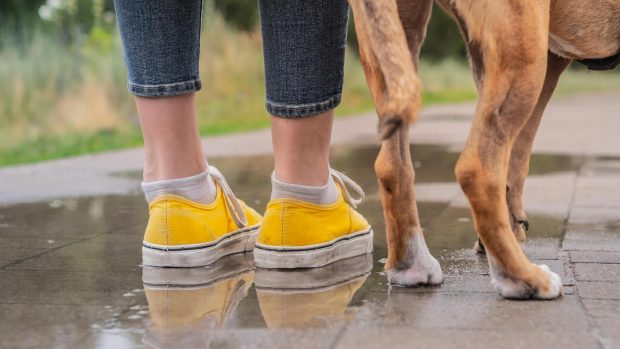Teaching your dog how to sit is usually done with a treat. Normally you hold your hand just in front of the puppy’s nose with the treat in view and gently push your hand towards the puppy’s nose while saying “sit”. Generally after a couple of attempts the puppy will get it and places his bottom on the floor. I then give the “yes” command as an affirmation, immediately followed by one of the best training treat for puppies. Read on if you want to learn how to teach a dog to sit, why it’s helpful – and when it’s not.
What is the first step in teaching a dog to sit?
You can start teaching a dog how sit when you bring your puppy home. Make it fun and rewarding – and never do it persistently for 10 minutes as they will get bored quickly, start to mouth or lose complete interest. A couple of minutes here and there helps the bond between you while introducing all the basic positions you will need for puppy classes.
When it a sit helpful?
It is helpful if a puppy can sit when…
- you start desensitising them – for example, when checking their eyes, ears nose and teeth and front claws.
- they are in the boot of a car so they do learn impulse control by sitting and waiting rather than leaping out.
- a dog feels overwhelmed by a situation – take them to some space or give them height to feel less vulnerable and allow them to sit and process what is going on at a safe height or distance with you sat next to them.
- around small children – this makes larger dog breeds less imposing and you can stand on the lead of a smaller dog breed if they try to jump.
- you are throwing objects to stop the immediate impulse to chase until a cue is given
- they need to wait while opening a door
- they are training to compete in obedience trials
Why won’t my dog sit?
You are holding the treat too high up
This will teach him to raise his paws in a begging gesture or even fall over backwards. If you hold the treat too high up, you are then coercing them to jump up instead of sit.
You are pushing down on his bottom
This is aggressive on their part given that a dog’s bottom is the point of all information for other dogs. By repeatedly pushing the dog’s bottom down with force into the sit, over time you will cause the dog turn sharply to look behind them. Then if another dog comes up to sniff, they are either immediately going to tuck their bottom underneath them, thus making them an anti-social dog, or get snappy to any dog or person that goes to touch its behind.
This causes real difficulties for vets taking temperature and squeezing anal glands, or groomers that need to trim and clean around the area. It is similar to a person getting your shoulder and slamming you down into a chair – not pleasant and completely unnecessary.
They’ll only sit for a treat
When dogs enter the teenage phase, there are better ways to follow through with your command without having to negotiate with dogs who will only do it for a treat every time. I prefer to slip my hand under their collar and then gently stroke down their back and tuck under their bottom, which makes them naturally sit down in a kind way.
I also incorporate the hand signal as I’m teaching a puppy. I like to have the palm of my hand facing me and then I bend my arm from the elbow, so my palm comes towards me and ends up at a right angle.
Be sure that your dog is just testing your boundaries, and that they are not in any pain either in the back or the hips if they are reticent to sit on command. You can also put your dog in the corner of the room and, as you move your hand backwards, they come up against the wall, which prompts them to sit. Knowing a dog and its personality is pivotal as this is working in an enclosed tight area and has the potential to make them frightened or panic.
Why is it important for a dog to sit?
To me, it’s not important. A dog’s natural position is to stand or lie down. It can be helpful for examination purposes or eyes and ears and teeth, and cutting a dog’s nails on the front paws – as it teaching your dog how to offer a paw. Some trainers and behaviourists find that the sit can teach good manners and help keep a dog under control. I think that depends on the dog.
A lot of dogs find sitting to be a trigger as the person’s body language is all wrong especially. There are trainers and owners who think teaching a dog to sit will stop a dog jumping, but usually the dog is sat in front of the owner and will launch out the minute he’s excited or lunge if it is scared.
There are plenty of dogs that do see sitting as an aid to getting themselves together and being able to take stock of the situations and the surroundings. However, this must be accomplished by the right body language and positioning of a handler.
Owners often make their dogs sit to take a treat. I prefer them to take it from the side that they are working otherwise the dog can learn to spin around in front of you and expect food. This can be dangerous when approaching roads and it is a bad habit.
I never make any of my dogs sit to cross a road. It doesn’t teach road sense as sitting before they cross a road does not make them rationalise that this is a danger – they just do it out of the habit you’ve created. Consider this. Would you like to put your bare bottom on a cold wet floor in winter, or a hot one in the summer? The answer is likely no, so why would your dog want to. I prefer my dogs to be standing before crossing a road, even more so when they are young and growing as the constant strain on the joints getting up and down is not healthy – especially if you have one of the larger dog breeds (65kgs and over).
When to sit and when to wait
The sit is something that does come into everyday life, but use it the right way and save it for when you really need it. I like to say is “quitting so much sitting” – and question whether the sit is always necessary? It is often taught as a default and it’s easy to overuse. I once had a client in class that would constantly say “sit, sit, sit, sit, sit” without pause. The dog came to the conclusion that was his name, so if I said the word sit he would immediately swivel is head to me as if to say “yes Helen, you have my attention”.
As I’ve mentioned, pups, senior dogs and certain breeds have a bone structure may make sitting painful and uncomfortable. Instead of using sit, a good steady stand wait is just as effective. It prevents pain or discomfort, and asking a fearful or reactive dog to sit in the presence of a trigger will only make the situation worse as you end up with your dog facing you rather than behind you. Giving your dog your back means you will keep it safe and deal with the trigger, while facing your dog puts it under pressure as the approaching trigger comes nearer, you now have your back to it seemingly inviting it over, which could cause your dog to have a complete meltdown.
You might also like:

How to teach your dog ‘Paw’

How to stop a dog barking at the fence

How to stop your dog chewing your home to shreds

How to stop your dog licking their paws: advice from an expert

How to stop a dog digging in the garden: advice from an expert

Why is my dog eating grass?

How to master loose lead walking

Subscribe to Horse & Hound magazine today – and enjoy unlimited website access all year round
Horse & Hound magazine, out every Thursday, is packed with all the latest news and reports, as well as interviews, specials, nostalgia, vet and training advice. Find how you can enjoy the magazine delivered to your door every week, plus options to upgrade your subscription to access our online service that brings you breaking news and reports as well as other benefits.




